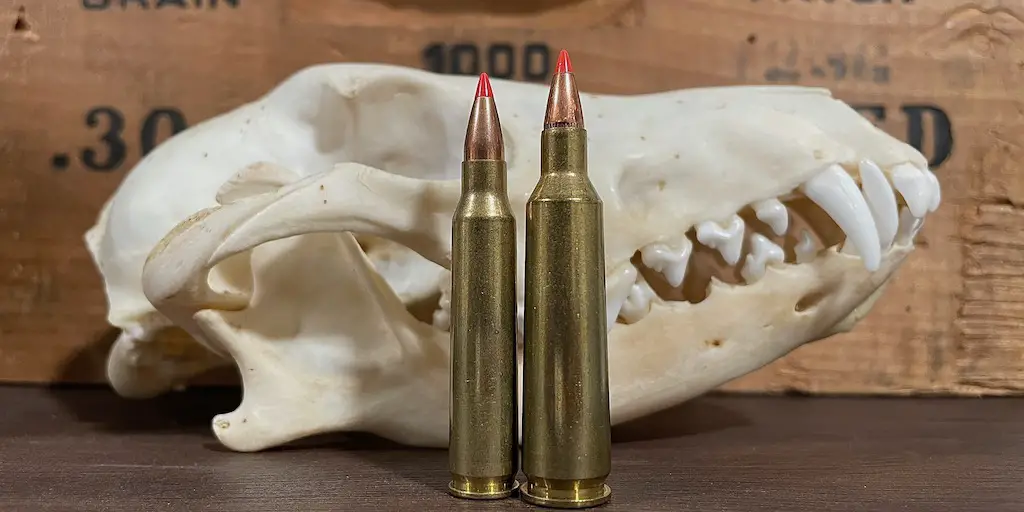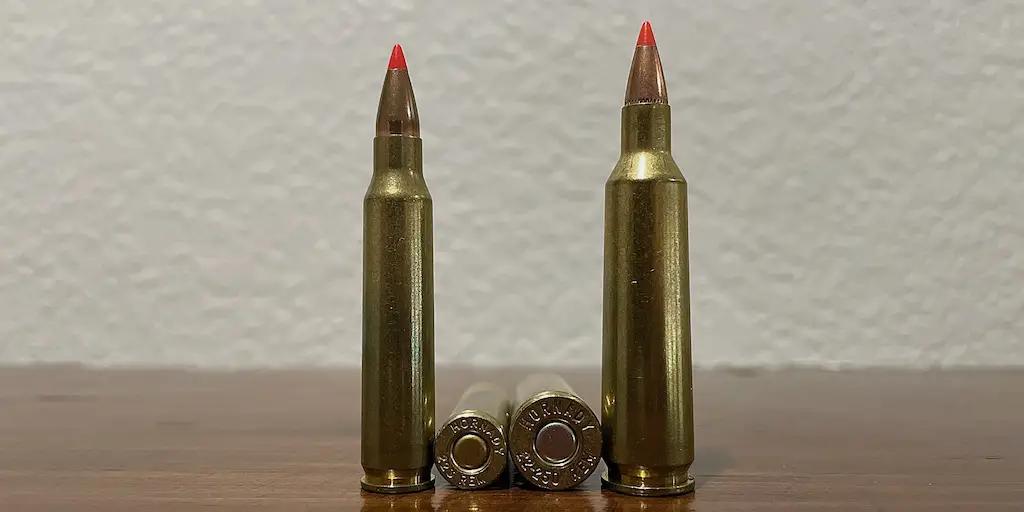Trying to decide between the 22-250 vs 223 Remington cartridges for coyote and varmint hunting? Here’s what you need to know about them.
How does the 22-250 Remington stack up next to the 223 Remington?
The 22-250 Remington utilizes a much larger case and is loaded to a higher pressure, so it can fire the same weight bullet 400-500fps faster than the 223 Remington. For this reason, the cartridge has a flatter trajectory, more muzzle energy, and more recoil.
It also usually (but not always) has more retained energy downrange and better resistance to wind deflection.
On the other hand, the smaller 223 Remington has less recoil and will function in an AR-15 (the 22-250 Remington is too big for use in an AR-15). The 223 cartridge also generally utilizes a faster rifling twist rate than the 22-250, which enables the 223 Remington to sometimes use more aerodynamic bullets.
For these reasons, the 223 Remington can sometimes approach or even exceed the performance of the 22-250 Remington under certain conditions, especially in the wind deflection and retained energy departments.
Want to learn more about the details of how these two cartridges compare to each other? To include how it’s possible the little 223 Remington can sometimes outperform the 22-250 Remington?
You came to the right place and I’ll tell you everything you need to know about these two cartridges.
Ask a few serious coyote hunters their opinion on the best coyote cartridge and they’ll likely name a couple different rounds between them. Two in particular will probably appear near the top of lists though: the 223 Remington and the 22-250 Remington.
That’s not surprising and those two cartridges can be incredibly effective on coyotes (and other predators and varmints) and both have accounted for literally truckloads of coyotes over the years.
While the 223 and 22-250 are both very popular coyote cartridges, and while there is a good amount of overlap in their performance and ideal use cases, there are some significant differences between the 22-250 vs 223 Remington.
Among other differences, each is ideally suited for different situations and for different styles of hunting. There are also some substantial variation in the types of rifles each cartridge is chambered in. The same is also true for ammunition.
With those things in mind, I investigate the 22-250 vs 223 Remington in detail in this article in order to provide some insight into which rifle cartridge is ideally suited for your specific hunting situation.
History Of The 22-250 Remington & 223 Remington
It seems that hunters and shooters have been searching for increased velocity ever since the early days of firearms development. This this trend really took off after the widespread adoption of smokeless powder at the beginning of the 20th Century.
Shooting a 150gr spitzer (pointed) bullet at a muzzle velocity of 2,700 feet per second, the original 30-06 Springfield loads produced during the early 1900s delivered a big jump in performance compared to the older 30-40 Krag (220gr round nosed bullet at 2,000 feet per second) that was also in common use at the time.
Compare that to the black powder loading for the 45-70 Government (405gr round nosed bullet at about 1,350 feet per second) and the 30-06 represented an almost quantum leap forward in bullet technology.
As fast as the 30-06 was at the time though, it didn’t take long for designers to start building even faster rifle cartridges. Developed by Charles Newton in 1913, the .250/3000 Savage (sometimes called the .250-3000 Savage) was the first commercially mass produced rifle cartridge to break the 3,000fps barrier.
The 250 Savage achieved that performance with an 87 grain .257″ bullet, but other designers realized there was potential for even faster velocities by necking that cartridge down to shoot even smaller diameter and lighter bullets.
That’s exactly what Grosvenor Wotkyns (who also designed the .22 Hornet) did a few years later. To Wotkyns’ chagrin, Winchester built their new high velocity .22 caliber cartridge using the 6mm Lee Navy as a parent cartridge instead of the .250/3000 Savage when they introduced the 220 Winchester Swift in 1935 though.
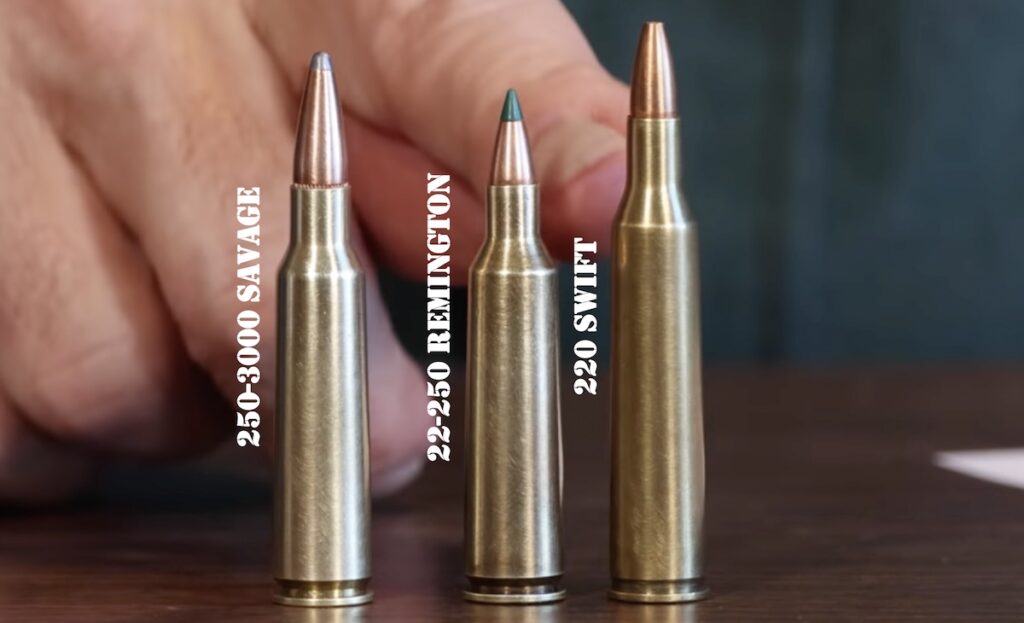
The original load for this cartridge, which is now primarily known as the 220 Swift, fired a 48 grain bullet at a screaming muzzle velocity of 4,140 feet per second (1,826 foot pounds of energy).
While the .220 Swift was easily the fastest cartridge in existence at the time and was incredibly effective on predators and varmints, the cartridge suffered through a number of problems.
Most notably, the .220 Swift initially gained a reputation as a barrel-burner. This limited the appeal of the cartridge to a certain degree (though it was still well received overall).
Even though Winchester opted not to utilize the .250 Savage as the basis for the .220 Swift, wildcatters continued to neck the Savage case down to .22 caliber over the next few decades. This resulting cartridge, which was widely known as the .22 Varminter, was also extremely effective on varmints.
In fact, the 22 Varminter cartridge was only slightly less powerful than the Swift, but achieved that level of performance using a significantly smaller case. It was also more versatile and easier to work with than the Swift.
Philip B. Sharpe said it best in his book The Complete Guide to Handloading (second revision of the third edition, p190 & 192):
The .220 Swift was not as flexible as had been anticipated and performed best when loaded to approximately the full velocity…The Varminter case is amazing in that it permits the most flexible loading ever recorded with a single cartridge. It will handle all velocities from about 1500 up to 4500 and the performance of most of the other standard and wildcat cartridges can be equaled.
For these reasons, varmint hunters really liked the .22 Varminter and the cartridge ended up surpassing the Swift in popularity even before the 22 Varminter received official standardization.
This is a pretty rare occurrence and wildcat cartridges will seldom surpass cartridges receiving backing from a major manufacturer (like Winchester provided to the 220 Swift). Furthermore, Browning even took the unusual step of manufacturing rifles chambered in the Varminter cartridge while it was still a wildcat.
The leadership at the Remington Arms Company knew a winner when they saw one and (just like they did with the .25-06 in 1959 and later the 7mm-08 in 1980), Big Green standardized the Varminter cartridge as the .22-250 Remington in 1965.
Not surprisingly, Remington hit a home run with the .22-250 and an even larger number of hunters flocked to the cartridge after the company began producing factory 22-250 ammo and reasonably priced, yet high quality Model 700 rifles for their new round.
The .22-250 Remington developed a reputation for mild recoil and exceptional accuracy from the start. Capable of flinging 50gr .22 caliber bullets at velocities in excess of 3,700 feet per second (and lighter bullets over 4,000fps), it also achieved a velocity and trajectory very nearly on par with the .220 Swift while utilizing a more efficient overall design that fit into a smaller package and burned less powder.
We’ll discuss the performance specifications of the 22-250 Remington in more detail here shortly, but just realize the flat shooting and hard hitting cartridge rapidly accumulated a massive market share among predator hunters after Remington officially threw their support behind it in 1965.
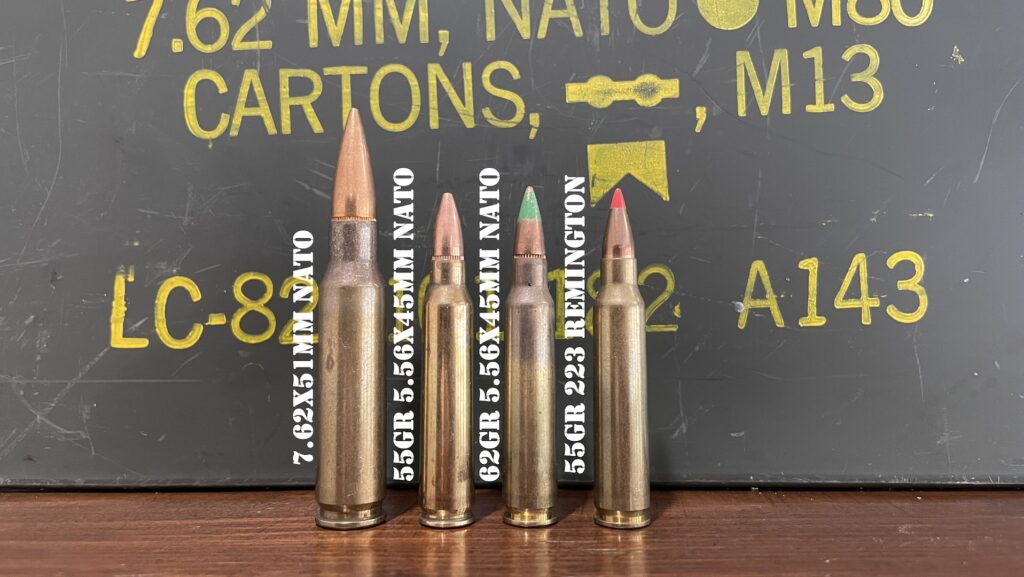
That wasn’t the only high velocity .22 caliber centerfire cartridge Remington adopted in the 1960s though.
The US Military began searching for a replacement for the relatively new M-14 rifle and 7.62x51mm cartridge just a few years before Remington officially adopted the 22-250. The military eventually settled on the M-16 rifle and the high velocity 5.56x45mm cartridge, which was derived from the .222 Remington.
Just like they did with the .22-250, Remington knew a winner when they saw it and standardized the new cartridge (which is very similar, but not identical to the 5.56x45mm) with SAAMI as the .223 Remington in the early 1960s.
With factory loads capable of pushing a 55-grain bullet at nearly 3,300fps (1,330 foot pounds of energy), the .223 Remington couldn’t quite match the performance of the .22-250 Remington on paper. However, those are still impressive ballistics and the .223 Remington fit in an even smaller package than the .22-250 and had less muzzle blast and recoil to boot.
Plus, this new cartridge functioned well while also delivering surprisingly good accuracy in the semi-automatic rifles that have since become very popular with varmint hunters and recreational shooters in more recent years.
223 vs 22-250 Remington Cartridge Sizes
As you can see in the photos below, there are some pretty major differences between the .223 Remington and .22-250 Remington cartridges.
First, though both fire the same .224″ (5.7mm) diameter bullets, there are some significant differences in bullet weights suitable for each cartridge.
The .22-250 normally shoots bullets in the 35-64 grain range.
However, since most rifles chambered in .22-250 Remington have 1:14″ rifling twists (which is SAAMI spec for the cartridge), they have trouble stabilizing heavier bullets. Therefore, 40, 50, and 55 grain bullets are most popular for the .22-250 Remington.
That’s not a hard and fast rule though and, for example, some modern production Browning rifles in 22-250 have 1:9″ twist rates that enables those rifles to effectively utilize heavier bullets.
On the other hand, faster rifling twists are much more common with the .223 Remington.
The SAAMI specified twist rate for the cartridge is 1:12″, but it’s not difficult to find rifles chambered in the cartridge with faster 1:10″, 1:9″, 1:8″ and even 1:7″ rifling twist rates that can stabilize longer and heavier bullets.
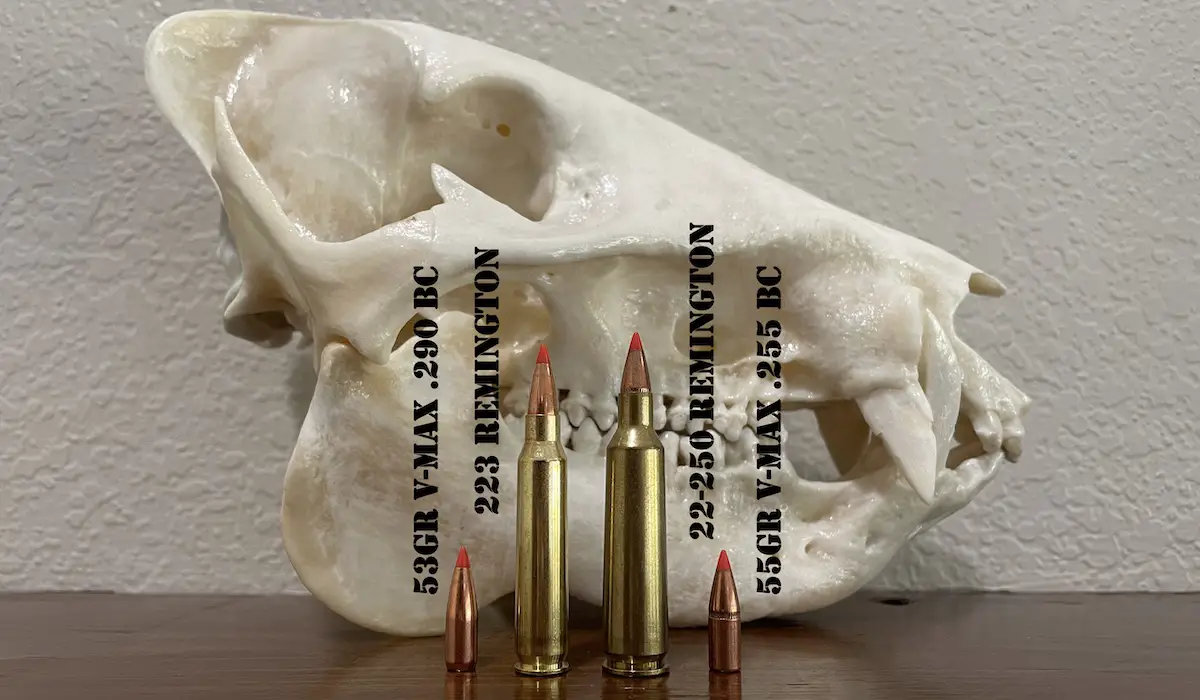
In fact, those faster twist rates are actually pretty common. We’ll discuss twist rates and rifle selection in more detail later in the article, but with all this in mind, the vast majority of .223 Remington factory loads shoot bullets in the 35-80 grain range.
Of these, 50 grain, 53 grain, 55 grain, 62 grain, and even heavier 75 and 77 grain bullet weights are most common.
We’ll discuss this more in a minute, but the faster twist rate of the 223 Remington enables that cartridge to use some longer, sleeker, and higher BC bullets in the 50-55gr weight range that the 22-250 can’t reliably stabilize with a 1:14 twist rate.
Next, the .223 Remington has a maximum overall length of 2.26″ which is shorter than the 2.35″ length of the .22-250 Remington. The AR-15 can only accommodate cartridges up to 2.26″ long, so the .223 Remington will fit in that rifle, but the 22-250 is too long.
Additionally, the .223 Remington has a .378″ (9.6mm) rim diameter. On the other hand, the .22-250 Remington is a larger rimless cartridge with a .473″ (12mm) rim diameter.
Additionally, the 22-250 has a 28 degree shoulder angle while the 223 Remington has a 23 degree shoulder angle.
Since it is both longer overall and has a larger diameter case, the .22-250 Remington has over 50% more case capacity than the .223.
Finally, the 22-250 Remington has a much higher 65,000psi SAAMI maximum average pressure levels than the 223 Remington’s 55,000psi.
Note: while the powder capacity figures listed below do give a good indication of the differences between the two cartridges, exact case capacities vary slightly according to the brand of brass used.
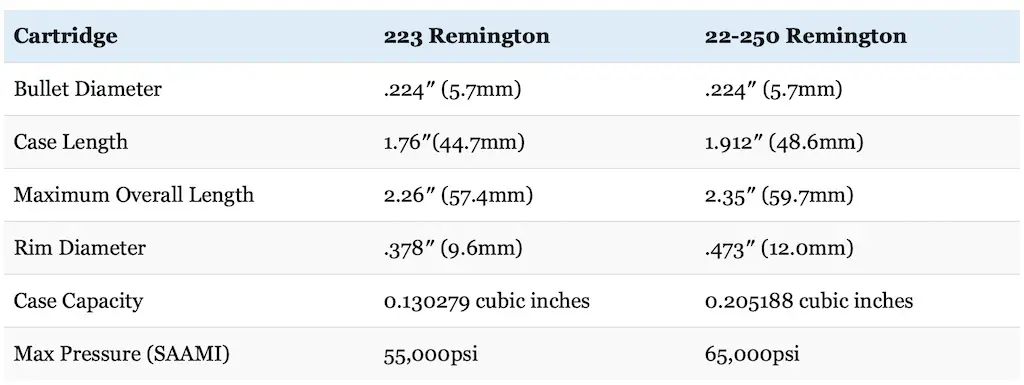
22-250 vs 223 Ballistics
The differences in the external dimensions of these cartridges also translate into some stark differences in their ballistic performance. This is illustrated in the table below comparing three different loadings for each cartridge from Hornady.
Specifically, the loads below are from Hornady’s Superformance Varmint and Varmint Express lines.
The .223 Remington loads use 35gr NTX (.177 BC), 53gr V-Max (.290 BC), and 55gr V-Max (.255 BC) bullets.
Likewise, the 22-250 loads below use 35gr NTX (.177 BC), 50gr V-Max (.242 BC), and 55gr V-Max (.255 BC) bullets.
Both 55gr offerings are “standard” loads that are representative of typical performance for the 223 Remington and 22-250 Remington.
The other four offerings are all from the Hornady Superformance® line they advertise as providing 100-200fps of additional velocity (without excess pressure) compared to standard loadings.
This is why those loads have such impressive muzzle velocities.
Furthermore, the NTX bullets are lead free varmint projectiles designed by Hornady for use on varmints in states like California that ban hunters from using lead bullets.
Additionally, Joe Thielen at Hornady designed that 53gr V-Max for optimal performance from a barrel with a 1-12″ twist rate. It will also work great in the faster twist barrels that are also common in the 223, but that bullet is a little bit more than what the 1:14″ barrels common on 22-250 rifles can properly stabilize.
All six loads used a 200 yard zero and were obtained using 24″ barrels.
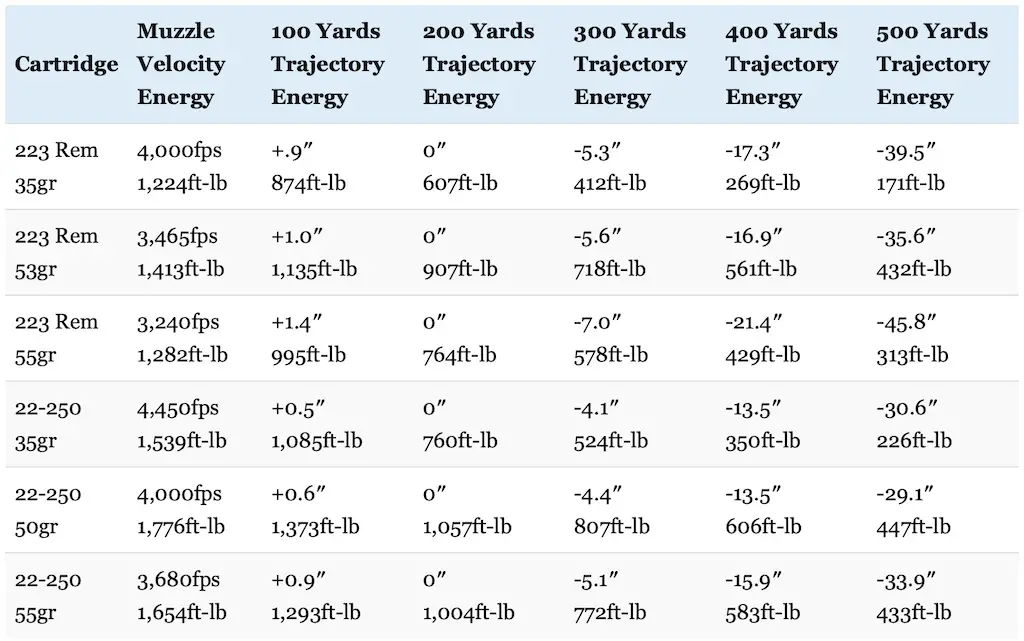
As you can see, the three 22-250 loads are actually the flattest shooting of the bunch. Though the 53gr V-Max from the 223 does really well, it still has nearly two inches more bullet drop than the 55gr V-Max load and about 6.5 inches more bullet drop than the 50gr V-Max load at 500 yards.
All things considered, every 223 Remington load has a less muzzle energy and a more arching trajectory than every 22-250 load due to the fact that the 22-250 shoots the same weight bullet (or a bullet of very similar weight) about 450-535fps faster than the 223 does with the same bullet type.
However, there are two outliers here you should take note of: the 35gr 22-250 Remington load and the 53gr 223 Remington load.
That 35gr NTX has a very low BC. Even though it starts out with a blazing fast muzzle velocity, that bullet quickly slows down and both the 53gr and 55gr V-Max loads for the 223 Remington surpass it in the energy department (before 100 yards for the 53gr and before 200 yards for the 55gr).
Additionally, like I mentioned earlier, the 53gr V-Max is a relatively high BC bullet for the 223 Remington. Combine that higher BC bullet with a faster than usual muzzle velocity for that 223 Superformance loading and you get a load that really punches above its weight for the cartridge.
Not only does that high BC 53gr 223 Remington load quickly surpass the 35gr 22-250 load by the time both bullets travel 100 yards downrange, but it also essentially catches the 55gr 22-250 load at 500 yards and falls just 3.5% short of the 50gr 22-250 load at that same range in terms of kinetic energy!
If you leave aside that 223 Remington load, the various 22-250 loads have about 9-45% more muzzle energy and fall within a range of about 38% less retained energy (the 35gr 22-250 load vs the 55gr 223 load) to 161% more retained energy at 500 yards than the other 223 Remington loads.
That’s quite a spread and shows how much things can change by tweaking muzzle velocity and BC like this.
All things considered, that 50gr V-Max loading for the 22-250 delivers the “best” overall performance out of all six loads to this point and has the most muzzle energy, the flattest trajectory, and the most retained energy at all ranges. That load does not use the highest BC bullet or have the fastest muzzle velocity, but it does well enough in both areas to come out on top overall (so far).
Here’s how each 223 load compares individually to the comparable 22-250 load in terms of muzzle energy, retained energy at 500 yards, and bullet drop at 500 yards:
35gr NTX: the 22-250 has 25.7% more muzzle energy, 32.2% more kinetic energy at 500 yards, and 8.9″ (22.5%) less bullet drop at 500 yards.
223 Remington 53gr V-Max vs 50gr 22-250 V-Max: the 22-250 has 25.6% more muzzle energy, 3.5% more kinetic energy at 500 yards, and 6.5″ (18.2%) less bullet drop at 500 yards.
223 Remington 53gr V-Max vs 55gr 22-250 V-Max: the 22-250 has 17% more muzzle energy, basically the same amount kinetic energy at 500 yards, and 1.7″ (5%) less bullet drop at 500 yards.
55gr V-Max: the 22-250 has 29.0% more muzzle energy, 38.3% more kinetic energy at 500 yards, and 11.9″ (26%) less bullet drop at 500 yards.
So, the big takeaways so far are that the 22-250 Remington is a flatter shooting and (generally) harder hitting cartridge, especially at long range.
Now let’s talk about another important factor: wind.
The chart below compares how much a 10 mile per hour crosswind impacts those same 223 Remington and 22-250 Remington loads out to 500 yards.
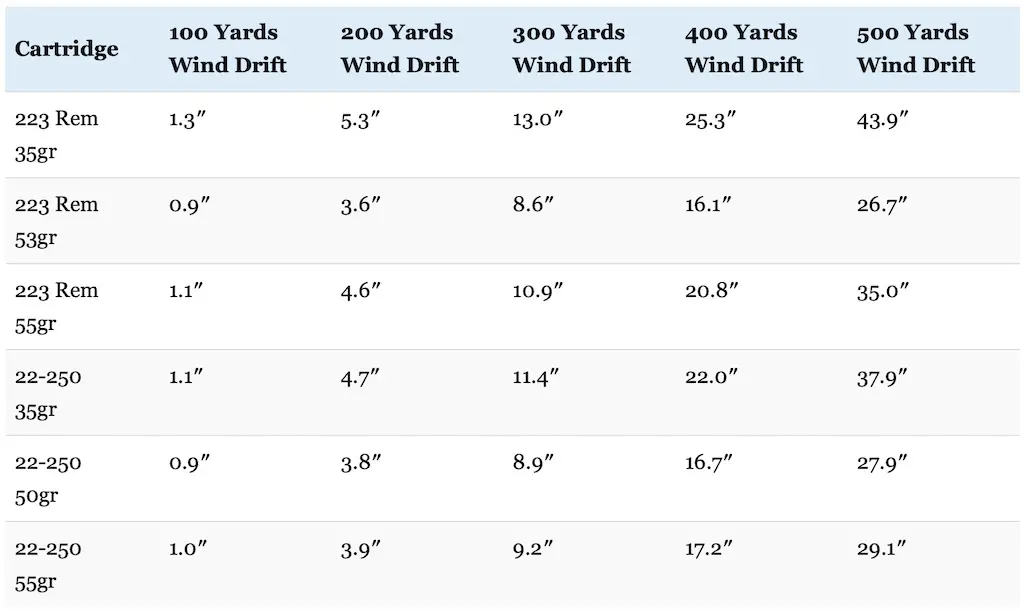
Interestingly, things are a little different here.
The 22-250 does have the advantage overall, but that’s exclusively due to the higher muzzle velocity of those loads. That higher muzzle velocity makes the 22-250 Remington clearly superior when comparing identical bullets and is sometimes even enough to overcome a small BC advantage in favor of the 223 Remington.
However, the 55gr V-Max bullet from the 223 Remington actually does pretty well here and surpasses that really low BC 35gr NTX from the 22-250 just shy of 200 yards.
Additionally, that higher BC 53gr V-Max from the 223 Remington actually has the least wind deflection out of all the loads compared here!
Why is this the case?
Assuming the same wind conditions, wind deflection is dependent on bullet velocity and BC. However, small changes in ballistic coefficient result in bigger changes in wind deflection than is the case with velocity.
This is why that 53gr V-Max has a clear advantage in terms of wind deflection, even when compared to bullets from the 22-250 that start out going nearly 1,000fps faster!
If that’s not a great example of the importance of BC to wind deflection, then I don’t know what is!
Here’s the breakdown by loading for wind drift at 300 yards and 500 yards:
35gr NTX: the 22-250 has 1.6″ (12.3%) less wind deflection at 300 yards and 6″ (13.7%) less wind deflection at 500 yards.
223 Remington 53gr V-Max vs 50gr 22-250 V-Max: the 223 has .3″ (3.3%) less wind deflection at 300 yards and 1.2″ (4.3%) less wind deflection at 500 yards.
55gr V-Max: the 22-250 has 1.7″ (15.6%) less wind deflection at 300 yards and 5.9″ (16.8%) less wind deflection at 500 yards.
All things considered, it would be reasonable to say that the 22-250 Remington does better in the wind than the 223 Remington.
However, this is an area where the details matter a lot and where the fact that the 223 Remington can use that higher BC 53gr V-Max can really pay some dividends.
External ballistics don’t tell the whole story though and there’s more to picking a hunting cartridge than kinetic energy, bullet drop, or wind drift at various ranges.
For instance, now let’s talk about recoil.
The table below compares the recoil produced by handloads that are very similar to the 55gr loads for the 223 Remington and 22-250 Remington when fired from identical rifles.
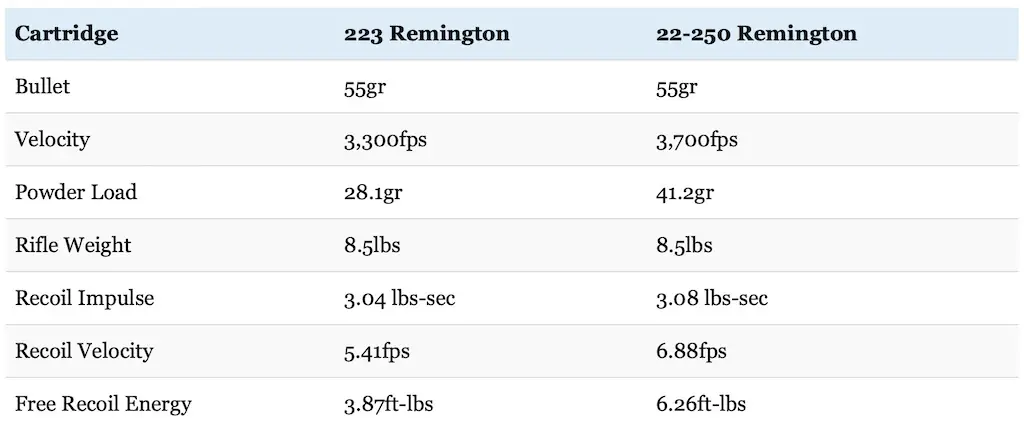
Felt recoil will vary from shooter to shooter and rifle to rifle, but free recoil energy is still a useful way to compare cartridges.
As you can see, neither cartridges recoils very much, but the 22-250 Remington has more recoil than the 223 Remington with this particular loading.
That load fires the same weight bullet at a faster velocity and uses a little more powder to achieve that performance. The end result is that the 22-250 Remington has about 62% more free recoil energy than the 223 Remington here.
That’s nothing, but let’s also not get carried away here either: both cartridges have an exceptionally mild recoil and virtually any person, regardless of size or age, should be able to handle them with ease. This is particularly true when shooting a heavy barrel varmint rifle.
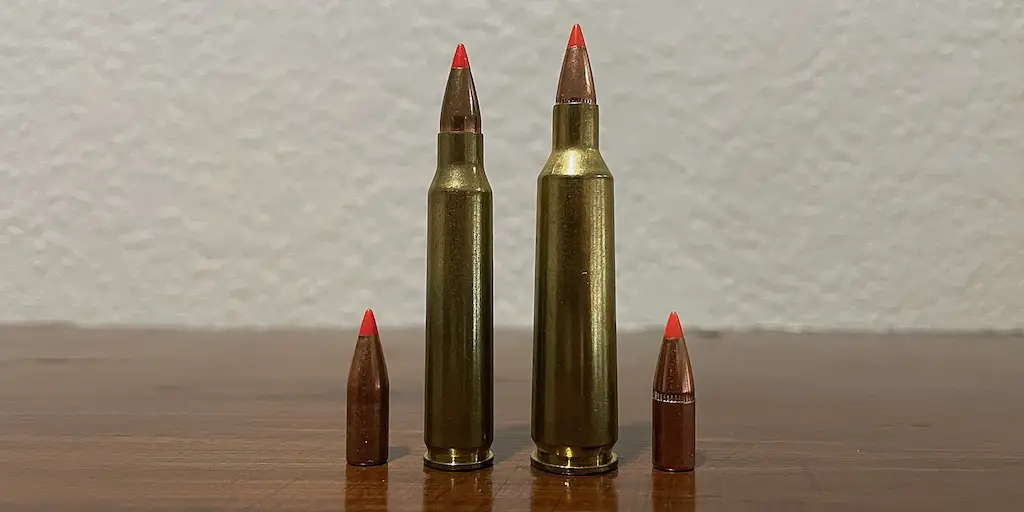
So where do we stand overall?
22-250 vs 223
The 22-250 Remington fires the same weight bullet much faster than the 223 Remington, but the 223 can sometimes utilize higher BC bullets. For this reason, the 22-250 has more recoil and a flatter trajectory and usually (but not always) more retained kinetic energy and better resistance to wind.
223 vs 22-250 Remington Ammo
Consistently ranking among the Top 5 best selling rifle cartridges in the United States each year (in fact, it’s often the #1 best selling rifle cartridge), the .223 Remington is by far the most popular of the two. That said, the .22-250 Remington by no means rare and is also in very widespread use.
In fact, pretty much every ammunition manufacturer of note like Armscor, American Eagle, Barnes, Black Hills, Browning, Double Tap, Federal, Fiocchi, Hornady, HSM, Nosler, PPU, Remington, Sierra, Sellier & Bellot, and Winchester (just to name a few) produce a wide variety of ammo for both the .223 and .22-250 Remington.
Since the .223 and .22-250 both use .224 cal bullets, virtually every major style of varmint bullet is available in these cartridges: the Barnes Varmint Grenade, the Berger Varmint HP, the Hornady NTX and V-Max, the Nosler Ballistic Tip and Varmageddon, the Remington AccuTip V, and the Speer TNT (just to name a few).
They’re all also available in a variety of plain old soft point bullets from a variety of manufacturers.
The .223 and .22-250 are also available in a few loads designed for big game hunting. For instance, both are offered in the Barnes VOR-TX line (a 50gr TSX for the 22-250 and 55gr, 62gr, and 70gr TSX for the 223/5.56).
Like I mentioned earlier though, the fact that 223 Remington rifles generally utilize a faster rifling twist rate enables the cartridge to utilize heavier and/or higher BC bullets.
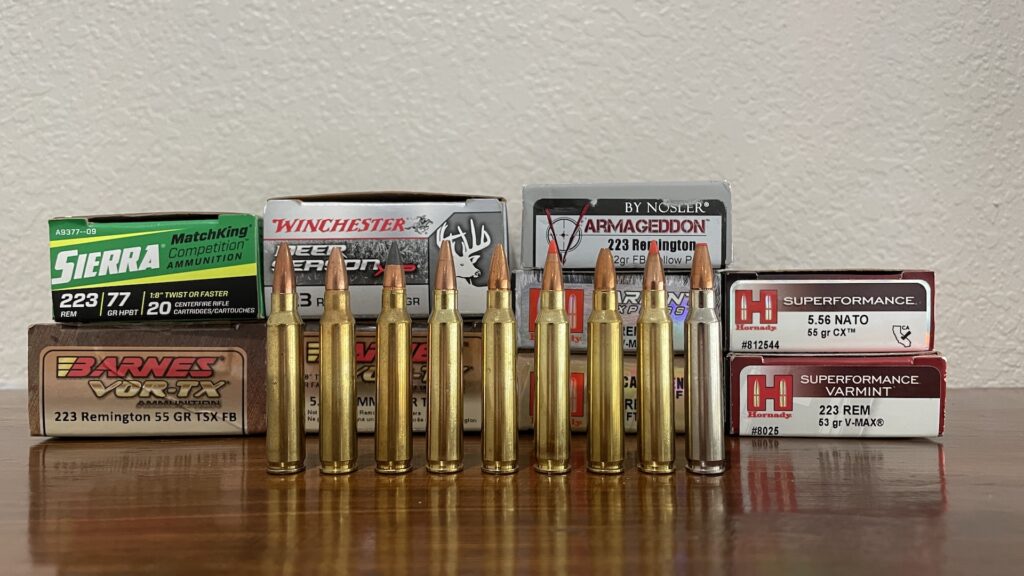
In addition to the 53gr V-Max I mentioned earlier, there are 223 Remington (or 5.56x45mm NATO) loadings utilizing projectiles along those lines like the 55gr, 62gr, and 70gr TSX from Barnes, the 62gr Fusion and 64gr Power Shok soft points from Federal, the 50gr and 55gr CX, the 73gr FTX, and the 75gr InterLock from Hornady, the 70gr AccuBond from Nosler, the 77gr Tipped MatchKing from Sierra, and the 64gr Power Point and Extreme Point from Winchester.
Winchester and Underwood respectively make a 64gr Power Point and a 60gr Ballistic Tip loads for 22-250 Remington, but that’s about it for bullet weights heavier than 55gr for the cartridge because most of those other projectiles won’t be properly stabilized by a 1:14″ twist rate.
Prices and availability vary from region to region, but the .223 Remington is by far the most common and least expensive.
If you’d like to learn more about some of the various hunting ammunition choices for the 223 Remington cartridge, read the article below:
Best 223 Remington Ammo For Hunting Deer, Hogs, & Other Game
223 vs 22-250 Rifles
The rifle situation with the 223 Remington and 22-250 Remington is similar to the ammunition situation: rifles chambered in .223 Remington are by far the most common, but there’s also a good selection of rifles for the 22-250 Remington.
Both are very easy to find in bolt-action hunting rifles like the Browning X-Bolt, CVA Cascade, Howa 1500, Mossberg Patriot, Remington 700, Ruger American, Ruger Hawkeye, Savage Axis, Savage 110, Tikka T3x, and Weatherby Vanguard.
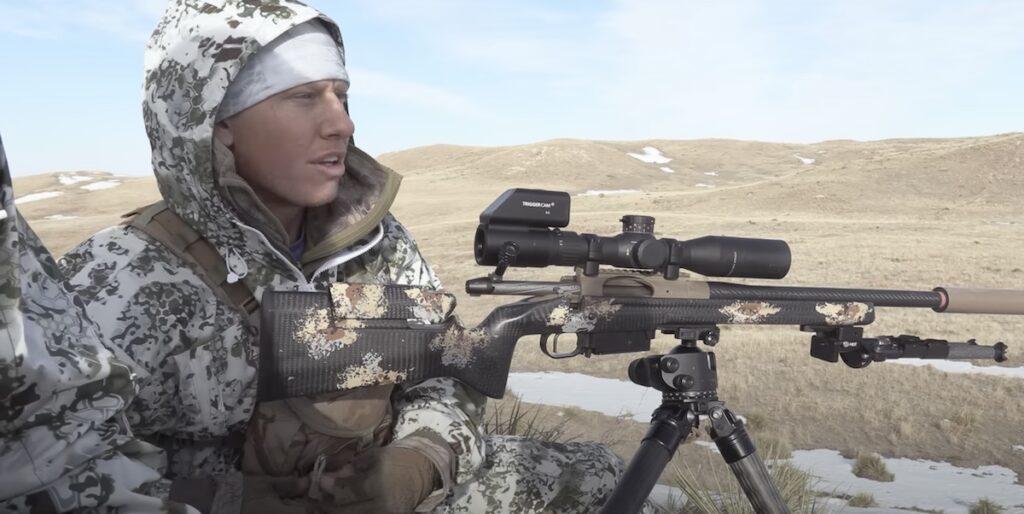
Both are also available in the Browning Lever Action Rifle (BLR).
The 223 Remington is also available in some rifles that are not manufactured in 22-250, like the Ruger American Ranch the Winchester XPR.
Likewise, Winchester currently makes their Model 70 rifle in 22-250 Remington, but not 223 Remington.
The .223 Remington is extremely popular in semi-auto platforms. In particular, AR-15 style rifles like those made by Bushmaster, CMMG, Daniel Defense, DPMS, Noveske, Ruger, and Wilson Combat, are extremely common with the .223 Remington. It’s also available in the Ruger Mini-Fourteen.
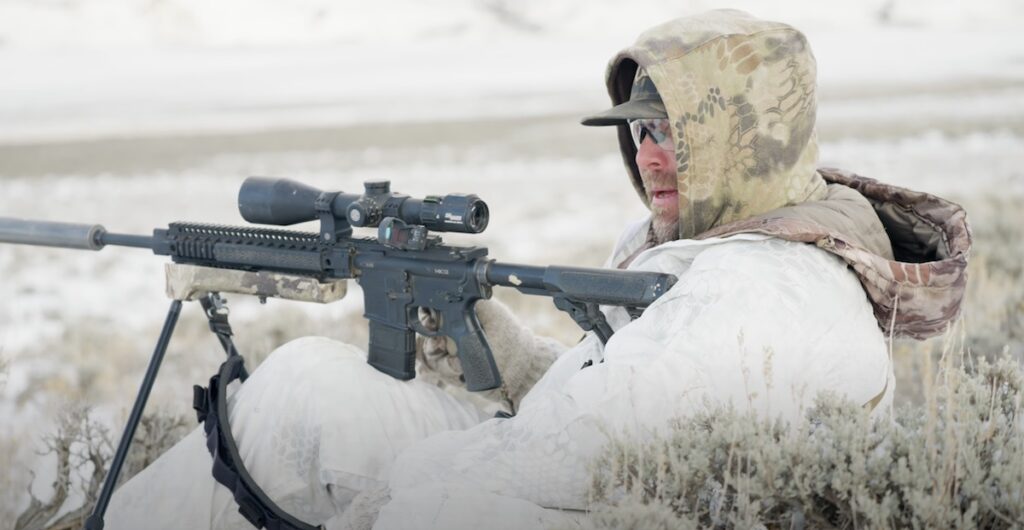
It’s possible to find the 22-250 in a semi-auto rifle, but it’s generally only manufactured in the larger and more expensive AR-10.
Remember what I mentioned earlier about the 223 Remington generally having a faster twist rate than the 22-250?
That’s usually true, but it’s not a hard and fast rule.
For instance, the 223 Remington versions of the BLR often use a 1:12″ twist rate and Browning makes several 22-250 Remington rifles with faster 1:9″ twist rates.
A hunter with a 22-250 that has a fast twist barrel can get the best of both worlds here by using those higher BC bullets while still taking advantage of the giant powder capacity of the 22-250 to push those heavy bullets really fast.
Heck, Ron Spomer has a 22-250 Ackley Improved in a custom rifle with a 1:8″ twist rate. That cartridge has an even larger case capacity than the regular 22-250 and he can achieve obscenely fast velocities with light bullets or still push a high BC 75gr or even an 80 gr bullet faster than the 223 can shoot a 55gr bullet.
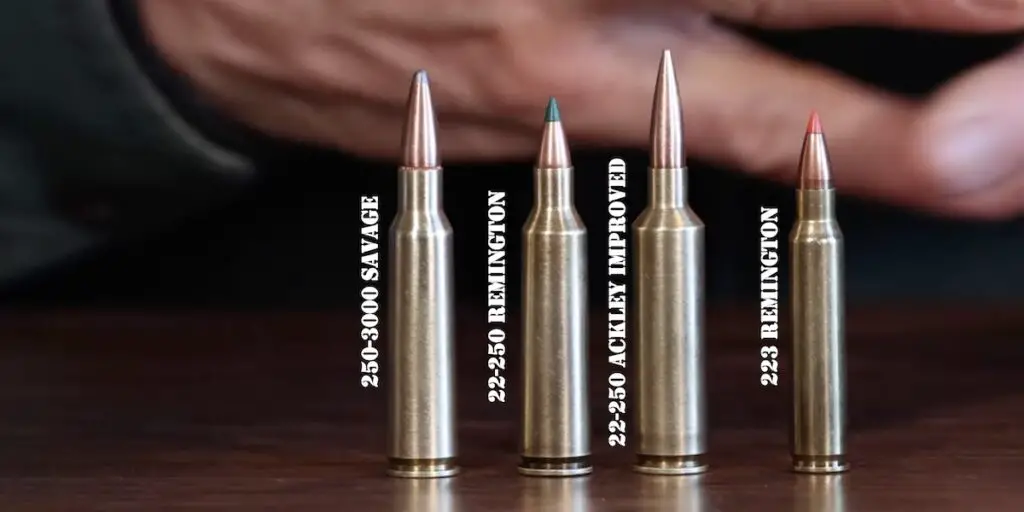
Additionally, we need to talk about barrel lengths.
Gun manufacturers tend to put longer barrels on rifles chambered in “hot rod” cartridges like the 22-250. This is because those cartridges need a longer barrel to effectively and efficiently burn that larger powder charge.
The 22-250 Remington is commonly available in rifles with 22″, and 24″ barrels, though you’ll occasionally run across rifles with longer 26″ barrels as well as shorter 18″ and 20″ barrels too.
On the other hand, 223 Remington rifles will often have a broad range of barrel lengths ranging from 16″ up to 22″ and sometimes even 24″.
16″, 18″, and sometimes 20″ barrels tend to be pretty common with semi-autos and bolt-action rifles will generally run in the 20-24″ range (but you can sometimes find shorter barrels on bolt guns and longer barrels on semi-autos).
Both cartridges will deliver reduced velocities out of shorter barrels, but the 22-250 will likely see a quicker drop off with a shorter barrel than the 223.
All of that is to say the details matter here.
For instance, a hunter purchasing a 22-250 with a faster twist barrel can use heavier and more aerodynamic bullets than the cartridge typically shoots. The opposite is true for a hunter buying a 223 Remington rifle with a 1:12″ twist rate.
Likewise, a hunter prioritizing a more compact and easy to carry rifle will have more options with the 223 Remington than the 22-250 and can use a rifle like that without giving up as much performance.
Having a shorter and handier rifle is more important on some hunts than on others. So, just keep that in mind.
223 vs 22-250 Remington: Which Is Right For You?
Are you looking for a good all around varmint or predator hunting cartridge? Both the 223 Remington and .22-250 Remington are excellent cartridges in this role.
The .22-250 Remington has a significantly flatter trajectory and (for the most part) carries more energy out to extended range, so it has a definite advantage as ranges increase as well for use on bigger varmints like coyotes.
Derrick Ratliff from Horizon Firearms is a serious coyote hunter who has done more than his share of coyote hunting. He likes to say that shooting a coyote is like trying to shoot a 2 liter soda bottle turned sideways. Doing that at 100 yards is one thing, but doing that at 200, 300, 400, or 500 yards is a whole lot more challenging, especially when you take into account that the coyote is often on the move.
A hunter can really start to appreciate a cartridge with the flattest possible trajectory (the least bullet drop) at longer ranges.
Situations like this are where the 22-250 Remington really comes into its own. When using lighter bullets like the Hornady 35gr NTX or 50gr V-Max that have muzzle velocities in excess of 4,000fps, the 22-250 has a very flat trajectory with minimal holdover out to 300 yards.
Not only does that cartridge’s really flat trajectory really aid hunters in making hits on a small target like that as the range increases, but the fact that the bullet (especially that 50gr V-Max) also carries a lot more energy downrange also helps too.
It works great at shorter range, but that cartridge really comes into its own in open country where longer shots are a possibility and a solid hit with a 22-250 Remington will often make a coyote fold up like a tent.
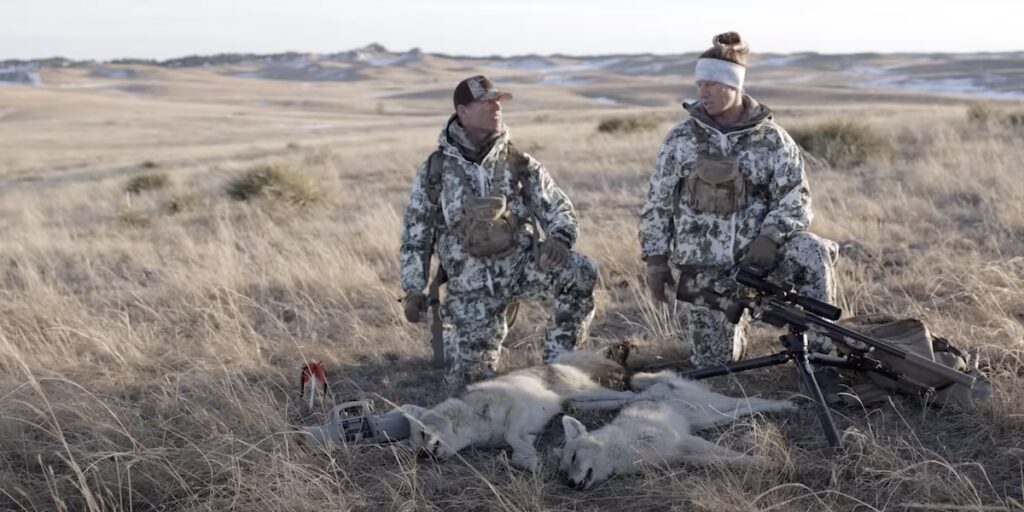
That extra retained energy can undoubtedly help in cases where shot placement is less than ideal and can mean the difference between a coyote that the hunter recovers and one that’s wounded and gets away.
None of this is to say the 223 Remington isn’t capable of cleanly killing coyotes. On the contrary, it can be extremely effective in that role and, with the right bullet and rifle set-up (think a bolt action rifle with a 22-24″ barrel shooting something like that Superformance ammo with a 53gr V-Max) nips right on the heels of the 22-250 at extended range.
The 223 is also a pretty flat shooting cartridge itself and only requires a little bit more holdover than the 22-250 inside 300 yards. If you’re hunting in thicker country and shots farther than that are uncommon, then the 223 isn’t really giving up much to the 22-250.
Sure, the 22-250 still has that advantage with a higher velocity, but does it make much difference whether you shoot a coyote at 75 yards with a 55gr bullet that left the muzzle at 3,680fps or 3,240fps?
Not really. That’s probably a dead dog either way.
The cartridge actually has a couple of very important strengths here too.
In fact, the widespread availability of the 223 Remington in semi-auto rifles can actually make this cartridge an even better option on coyotes in a situation where a hunter might have multiple dogs responding at once. It’s a plain fact that a hunter with an AR-15 in 223 is more likely to score a double or even a triple if multiple dogs come in together compared to a hunter with a bolt-action rifle in 22-250.
The same is also true for follow up shots where the hunter fails to connect on their first try.
No less an authority on coyote hunting than Geoff Nemnich uses an AR-15 chambered in 223 Remington for all his coyote hunting. He especially likes that Hornady Superformance load with the 53gr V-Max.

Don’t forget that the 223 Remington is more common in rifles with shorter barrels and doesn’t give up as much performance as the 22-250 in shorter barreled configurations. Those shorter and easier to maneuver rifles also come into their own at close quarters, so keep that in mind as well.
Coyotes aside, the 223 Remington isn’t giving much performance at all to the 22-250 Remington on smaller predators and varmints like foxes and prairie dogs. In fact, the 223 Remington is probably a better choice for higher volume shooting on varmints than the 22-250 here too unless shots at longer range are expected.
The 22-250 isn’t as big of a barrel burner as something like the 220 Swift, but it’s definitely worse in that regard than the 223 and care must be taken during high volume hunting situations to let the barrel cool between shot strings.
It will darn sure work great on smaller varmints like prairie dogs though. For example, Who Tee Who took his 22-250 to Wyoming for a prairie dog hunt back in 2023. Let’s just say the results were “impressive” with plain old 55gr Remington pointed soft points.
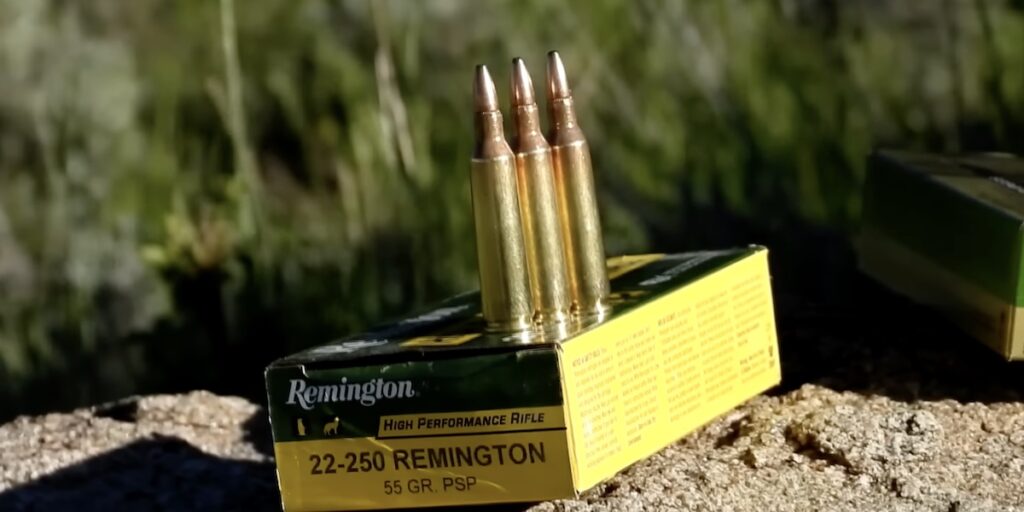
Do you want a cartridge ideal for hunting big game like feral hogs and deer? First, beware that .22 caliber cartridges are not legal for big game hunting everywhere. I don’t necessarily advocate using the either on big game, but assuming they are legal to hunt with where you live, and especially with production rifles and factory ammo, the 223 Remington is by far the best for hunting big game because more rifles chambered in the cartridge have a fast rifling twist that’s capable of stabilizing longer and heavier bullets. There’s also a much bigger supply of .223 Remington factory ammo suitable for big game hunting (like the Barnes VOR-TX, the Hornady CX, and the Nosler AccuBond, E-Tip, and Partition) than the 22-250.
The 223 Remington is somewhat widely used for feral hog control in particular, often in the AR-15 platform and sometimes with thermal sights at night. Regardless of the details, is can be extremely effective in that role, but this cartridge simply requires more exacting shot placement than other, more powerful cartridges like the 243 Winchester, 6.5 Grendel, 6.5 Creedmoor, 6.8 SPC, 300 Blackout, or 308 Winchester.
I know some hunters who have taken literally truck loads of hogs using these cartridges too (but especially the 223 Remington from an AR). Hogs never go far after a hit to the central nervous system or to a high shoulder shot, but they sometimes require more than one hit to put down quickly from a regular hit to the heart/lungs.
If the hunter only gets one shot and if it’s not right on the money with .22 caliber centerfire, hogs have been known to go a pretty good distance and often be difficult to track. They usually die, but finding and recovering them isn’t always easy.
The situation can sometimes be a little different with deer though.
For instance, the gentleman in the photo below has taken a few young red stag (~150-175 pounds live weight) using the 223 Remington and had great results in the process.

That being said, the .22-250 Remington can also work in this role too. Barnes, Hornady, and Nosler manufacture .224″ TSX, CX, E-Tip, and Partition bullets (and a factory load for the 22-250 too in the case of the 50gr TSX). In that case, the only thing really stopping a handloader from building a good deer hunting load for the .22-250 would be the rifle itself, which may or may not accurately shoot those bullets (a 50gr CX or TSX will probably be fine, but the others may need a faster twist rate, especially in heavier grain weights).
To that end, another gentleman I know has taken a few whitetail deer using the 22-250.
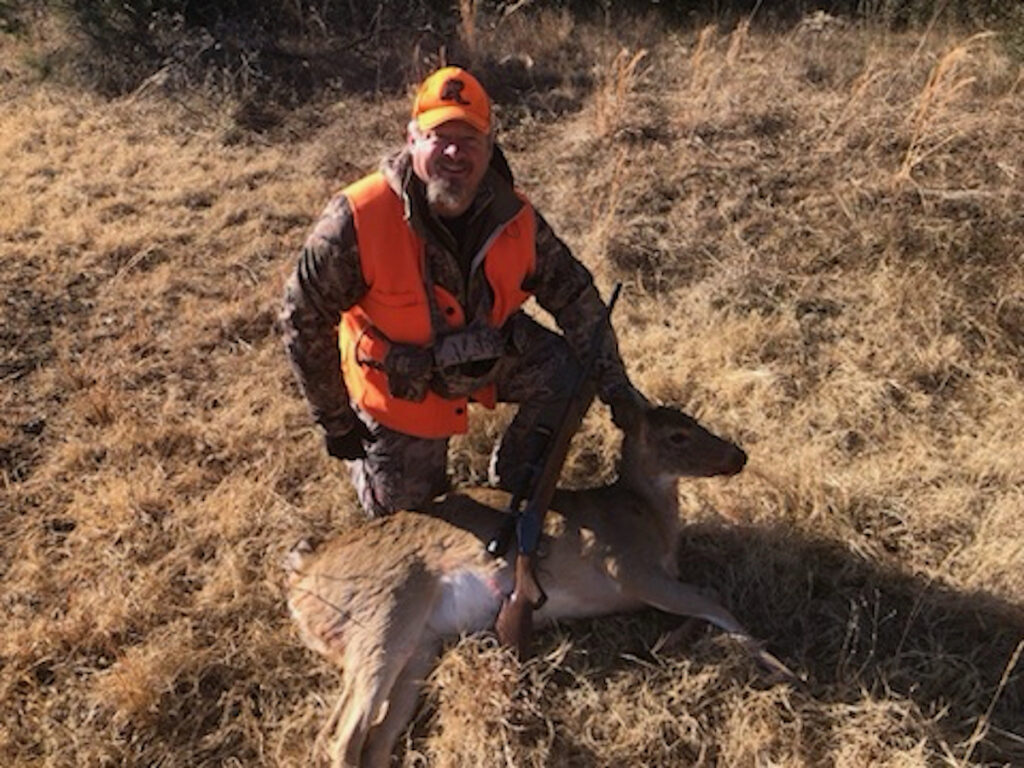
In each case we’re not taking about gigantic animals, but the 223 Remington and 22-250 Remington were both devastating on those deer. Slip one of those high velocity bullets behind the shoulder into the lungs and no deer will go far.
I personally wouldn’t recommend using either cartridge on game bigger than deer though.
Are you looking for a cartridge with lots of inexpensive ammo for general plinking or target shooting? The .223 Remington wins hands down here since it’s arguably the easiest to find and least expensive centerfire cartridge in the United States. Heck, the 223 is one of the most popular centerfire rifle cartridges in the entire world and you’re much more likely to find cheaper ammo for it just about anywhere.
Are you very sensitive to recoil? Depending on what exactly you want to do with the cartridge, both will work really well, though the .223 Remington has significantly less recoil than the .22-250.
Are you looking for an ideal cartridge to use in an AR-15 platform? The .223 Remington is the only real choice here and there are countless good quality AR-15 style rifles chambered in .223 Remington or 5.56x45mm NATO.
Do you want a cartridge suitable for home defense, a SHTF scenario, or a tactical situation? Due to the wide variety of semi-auto rifles and large supply of ammunition designed specifically for the task, the .223 Remington also has a major advantage here. For those same reasons, the .223 Remington is clearly the better choice for practical shooting competitions.
Though the differences between them (22-250 vs 223) are fairly significant in some respects, both are highly capable predator and varmint cartridges. There’s a fair amount of overlap in their best use cases, but each is also best suited for unique conditions.
For this reason, you should carefully analyze your potential needs before making a decision. In the end, a lot of this decision comes down to personal preference, the exact game you’re after, and the conditions of your hunt. So, choose the one that you feel most comfortable with and it will probably serve you well afield. Good luck!
NEXT: BEST 6.5 CREEDMOOR AMMO FOR HUNTING ELK, DEER, & OTHER BIG GAME
NEXT: BEST GIFTS FOR HUNTERS
Enjoy this article comparing the 223 Remington and 22-250 Remington cartridges? Please share it with your friends on Facebook and Twitter.
The Lyman 50th Edition (p139-143 & 148-151), Hornady 10th Edition (p160-178 & 200-209), and Speer Number 10 (p120-123, 134-141) reloading manuals as well as The Rifle In America by Philip B. Sharpe (p712-713) were used as references for the history of the cartridges. The data used to compare the trajectory and wind drift of the cartridges was obtained from Hornady (here, here, here, here, here, and here). Case capacity information for the 22-250 vs 223 were obtained from Backfire.TV. I used Shooters Calculator to compare trajectories, wind drift, and recoil for the cartridges. Maximum pressure obtained from SAAMI (p25 and p26).
Make sure you subscribe to The Big Game Hunting Podcast and follow The Big Game Hunting Blog on Facebook, Instagram, Twitter, and YouTube.
John McAdams is a proficient blogger, experienced shooter, and long time hunter who has pursued big game in 8 different countries on 3 separate continents. John graduated from the United States Military Academy at West Point and is a veteran of combat tours with the US Army in Iraq & Afghanistan. In addition to founding and writing for The Big Game Hunting Blog, John has written for outdoor publications like Bear Hunting Magazine, The Texas State Rifle Association newsletter, Texas Wildlife Magazine, & Wide Open Spaces. Learn more about John here, read some of John’s most popular articles, and be sure to subscribe to his show: the Big Game Hunting Podcast.

